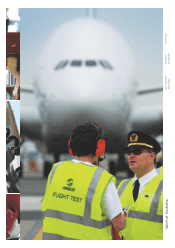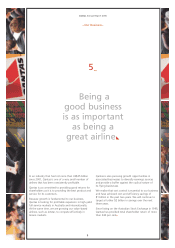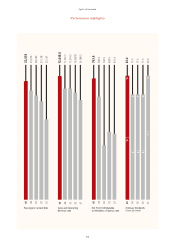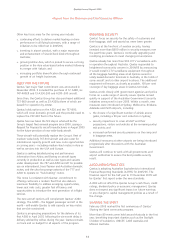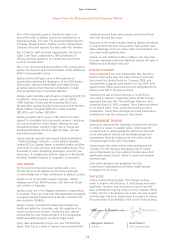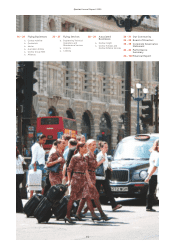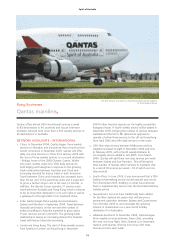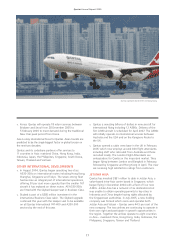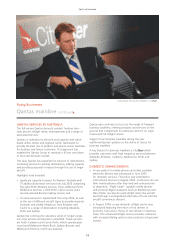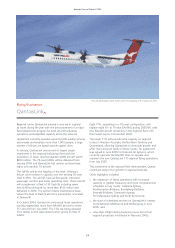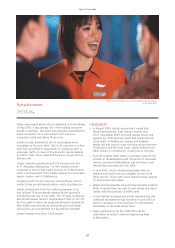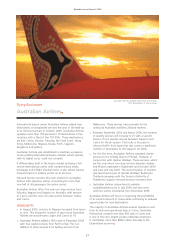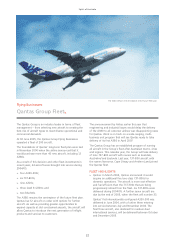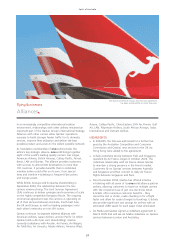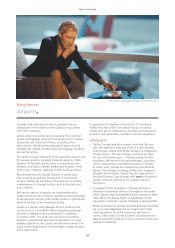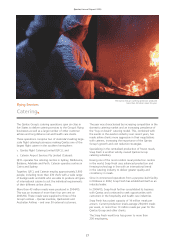Qantas 2005 Annual Report Download - page 19
Download and view the complete annual report
Please find page 19 of the 2005 Qantas annual report below. You can navigate through the pages in the report by either clicking on the pages listed below, or by using the keyword search tool below to find specific information within the annual report.
17
x Korea: Qantas will operate 18 return services between
Brisbane and Seoul from 28 December 2005 to
5 February 2006 to meet demand during the traditional
New Year peak period from Korea.
Asia is a key international focus for Qantas. Asian tourists are
predicted to be the single biggest factor in global tourism in
the next two decades.
Qantas and its codeshare partners offer services to
11 countries in Asia: mainland China, Hong Kong, India,
Indonesia, Japan, the Philippines, Singapore, South Korea,
Taiwan, Thailand and Vietnam.
OTHER INTERNATIONAL DEVELOPMENTS
x In August 2004, Qantas began operating two-class
A330-300s on international routes including Hong Kong,
Shanghai, Singapore and Tokyo. The seven-strong fleet
has become an integral part of international operations,
offering 30 per cent more capacity than the smaller 767
aircraft it has replaced on these routes. All A330-300s
are fitted with the Skybed sleeper seat in Business Class.
x Skybed is part of a $385 million investment in the
international Business Class cabin. The Skybed upgrade
continued this year with the sleeper seat to be available
on all Qantas International 747-400 and A330-300
services by the end of this year.
x Qantas is investing billions of dollars in new aircraft for
international flying including 12 A380s. Delivery of the
first A380 aircraft is scheduled for April 2007. The A380s
will initially operate on international services between
Australia and the USA and on the Kangaroo Route to
the UK.
x Qantas opened a cabin crew base in the UK in February
2005 which now employs around 400 flight attendants,
including staff who relocated from Australia and those
recruited locally. The London Flight Attendants are
ambassadors for Qantas in this important market. They
began flying between London and Bangkok in February,
followed by Singapore and Hong Kong in April. The crew
are receiving high satisfaction ratings from customers.
JETSTAR ASIA
Qantas has invested S$51 million to date in Jetstar Asia, a
value-based intra-Asia carrier based in Singapore, which
began flying in December 2004 with a fleet of four new
A320s. Jetstar Asia has a network of six destinations but
was unable to obtain operating permits to key cities in
Indonesia and China despite having rights allocated by
the Singaporean authorities. In July 2005, a new holding
company was formed which owns and operates both
Jetstar Asia and Valuair – Qantas owns 44.5 per cent of the
new company. The two airlines are continuing to operate in
their own right and participate in growth opportunities in
the region. Together the airlines operate to eight countries
in Asia – mainland China, Hong Kong, India, Indonesia, the
Philippines, Singapore, Taiwan and Thailand.
Qantas Annual Report 2005
Qantas operates A330-300s to Hong Kong


